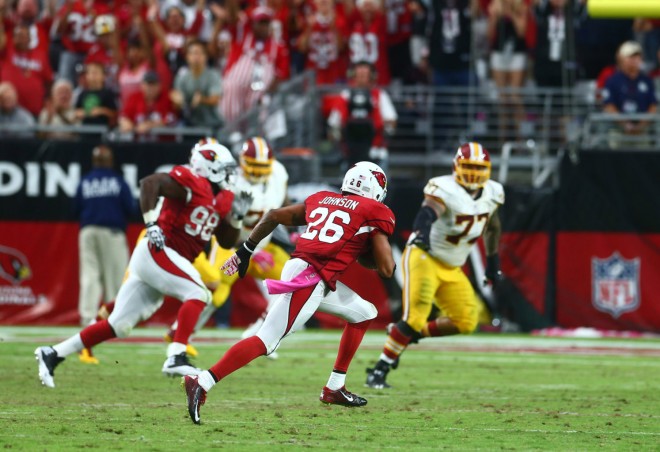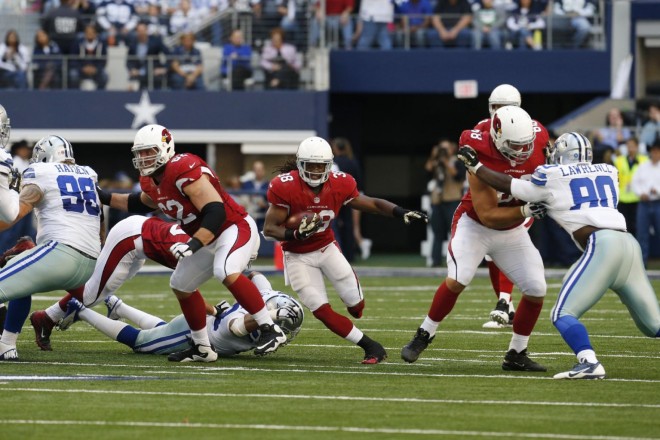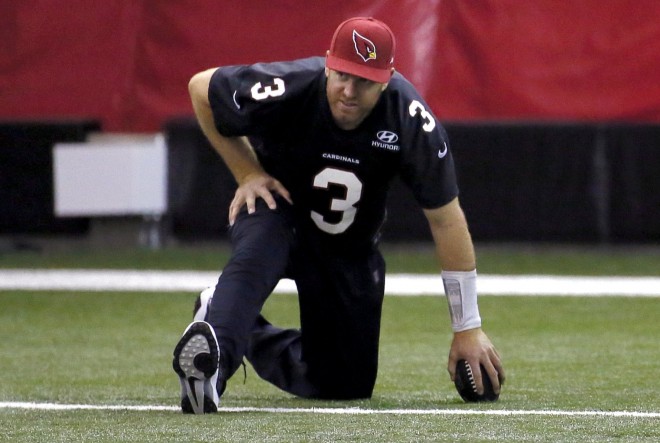It would be easy to forgive the Arizona Cardinals for playing this season with a massive chip on their shoulder. Could they really be blamed, after getting denied a playoff spot last year in spite of finishing with 10 wins? The writing was already on the wall, as evidenced when they downed Seattle at CenturyLink Field in what turned out to be the only home loss for the eventual Super Bowl champions. Carson Palmer was not spectacular but steady, and Andre Ellington and Michael Floyd were emerging as reliable offensive weapons to go with their top-ranked rushing defense, anchored by the likes of veteran John Abraham, Daryl Washington, and Calais Campbell among their front seven.
With division rivals San Francisco and St. Louis hit hard by injuries entering 2014’s kickoff, there was a feeling among analysts that Arizona would be able to build on the success (and frustration) of the previous season to contend with Seattle for the division crown. In doing so, Arizona would also inject itself squarely into the NFC playoff picture.
Based on the first half of the season thus far, they have responded to the challenge, and then some. With all NFC West bye weeks completed, this picture tells a thousand words:

A 2-game lead after just 8 games is no mean feat, and is just one indicator of why fans and observers need to be taking more notice of these Arizona Cardinals. Also worth keeping in mind is that the one blemish on their record this season was at a tough venue in Denver, and even then, it was a game where they were only down a field goal going into the final quarter of the game. Not historically known for being a winning team, fans have had to stomach two 5-11 seasons in the time since those playoff runs of 2008 and 2009, the former ending up in a Super Bowl berth that came within a tiptoe catch from glory. This year, it looks more and more certain that this same fanbase will have plenty of reason to be excited.
“Are the Cardinals the Real Thing?”
As TheAOSN.com examines the league’s best record at this midway point of the season, the question above is certainly worth asking. This analysis will consider the following in determining just how legitimate Arizona is as an NFC and NFL contender: Statistical breakdown, areas of concern, and the remaining schedule.
“Yes, Because Numbers Don’t Lie”
The old sporting cliche goes “Offense wins games, defense wins championships.” If that holds true, then Arizona has a decent shout this season. The defensive front is not only continuing its marvelous work in stopping opponents from running against them (3rd-ranked currently), but they are doing it while giving up less yards than last season’s average (2014: 79.6 ypg; 2013: 84.4 ypg). Teams that have attempted to establish a ball control offense against this team have all fallen short. It is perhaps no coincidence that in the 4th quarter of the one loss against Denver, key defensive lineman Calais Campbell had been ruled out to injury after a chop block.

Remarkably, as proficiently as they stop the run, the pass rush has been non-existent, and they currently rank 30th in the league with only 8 sacks so far, averaging just 1 sack per game. The lack of a pass rush has created time for opposing quarterbacks to find gaps in coverage, and even with stars like Patrick Peterson, Antonio Cromartie, and Tyrann Mathieu in the defensive backfield, this secondary is ranked dead last in the league, giving up almost 287 yards per game. The only teams giving up more yards per pass attempt than Arizona? Atlanta (2-6), Tampa Bay (1-7), Chicago (3-5), New Orleans (4-4), Oakland (0-8), and St. Louis (3-5). Not exactly a group of teams to be proud of topping.
While they are giving up generous yardage, this looks like a case of bending but not breaking, since they still somehow rank among the top 5 in scoring defense (19.5 ppg) while giving up more than 365 yards of offense per game. Perhaps as a function of being so vulnerable to the pass, where one could logically assume more attempts and completions by opponents per game, the defensive backs have made up somewhat by making key interceptions, allowing Arizona to lead the league in interceptions with 12 thus far.

On the offensive side of the ball, 34-year old Carson Palmer battled a nerve injury to his throwing shoulder in September, but having returned to action, he looks in fine form, playing with career highs in his QB Rating and touchdown:interception ratio through 5 starts. In fact, his yardage so far would rank among the top 5 in the league if his starts were extrapolated to match the league leaders. Drew Stanton was efficient starting in place of Palmer, and the experience from earlier this season will be handy should anything unforeseen occur. The offensive line has done a tremendous job in protection, as Arizona quarterbacks have only been sacked a total of 13 times, with Palmer only getting floored 6 times so far.
It is behind this offensive line that Andre Ellington has been able to showcase his skills, averaging 109 yards of offense per game, and placing among the top 3 in the league for receiving yardage by running backs. There was some concern that too much was being asked of him, but with less than 20 carries per game, there should not be too much to worry about in this area. However, it is also worth noting that the talent dropoff from Ellington to Marion Grice and Stepfan Taylor is a fairly immense gap.

While it was inevitable that the day would eventually come when this sentence had to be written, it is still a fairly jarring realization of how the sands of time progress:
Larry Fitzgerald is no longer a WR1.
With 2 1400+ yard seasons in 2008 and 2011, Fitzgerald threw his name into contention among the league’s best wide receivers, but having failed to surpass 1,000 yards the last 2 seasons, it has become obvious that his best days are past him. There is no shame in this for Fitzgerald or the team, and it has got to be a comfort to Palmer to know that there is still a reliable safety valve in him. While he still leads the team in yards so far this season, and has a real shot at cracking the 1,000 yard mark, 3rd-year pro Michael Floyd and rookie John Brown are emerging as a dynamic receiving duo with equal amounts of speed and strong hands. It is surely only a matter of time before head coach Bruce Arians leans more on his young receivers, as they have the potential to be among the league’s top pass-catching tandems, bringing to mind Arizona’s last top duo of Anquan Boldin and…………Larry Fitzgerald.

The offense is among the league leaders in 3rd-down efficiency, converting over 45% of its third downs. Maintaining this solid conversion rate will allow Arizona to control game tempo and establish ball control. As the season wears on and conditioning becomes a factor, there is nothing much more valuable than the ability to keep an opponent’s defense on the field.
“Yes, But…..”
As with all teams hoping to be championship contenders, Arizona is no exception. There are several areas of concern that must be addressed by the team if they are going to make a deep run in the playoffs:
1. Pass rush: Or lack thereof. Teams are going to throw against them – They know this, the fans know it, and everyone watching knows it. To ease some of the pressure on their secondary, the defensive front is going to have to find a way to put more pressure on opposing QBs and collapse pockets. In a pass-oriented league, and in a conference with Drew Brees, Aaron Rodgers, a Chip Kelly offense, etc., it is imperative that Arizona begins to get more of a push up front on defense.

2. Keep Palmer and Ellington healthy: One advantage of such a hot start is that by late November going into December, Arians may find himself with the luxury of being able to limit snaps for his key starters. There is depth in several areas of the team for postseason play, but not under center and in the backfield.
3. Improve the running game: Currently, the team sits ranked 28th in rushing yards per game. While the aforementioned 3rd-down efficiency is admirable, there still needs to be improvement in this area. The potential effect of this is twofold: (a) Increasing Ellington’s touches per game (thereby jeopardizing point #2 above) until and unless Grice and Taylor begin to show rapid development, and (b) Opens options up for Palmer in the passing game which, when combined with a better running game, will give Arizona a huge edge in time of possession.
If these 3 points are addressed, do not be surprised to see this team play even better than they have so far this season.
“Yes, They Have a Friendly Schedule”
Skimming through the remainder of Arizona’s schedule, it is hard to not envision a scenario where they would end up with a first-round bye, and perhaps even home field advantage throughout the playoffs – an advantage that is even further magnified by the fact that the 2015 Super Bowl will be held at the University of Phoenix Stadium, otherwise known as the home field of the Arizona Cardinals.
November 9th St. Louis (3-5)
November 16th Detroit (6-2)
November 23rd @Seattle (5-3)
November 30th @Atlanta (2-6)
December 7th Kansas City (5-3)
December 11th @St. Louis
December 21st Seattle
December 28th @San Francisco (4-4)
Having to play 3 division games on the road is a tough ask, and St. Louis could spring an upset at the Edward Jones Dome with Arizona coming off a short week of rest. Playing the toughest non-division opponent Detroit at home will be helpful. This article is not suggesting that they could run the table and finish 15-1, but 14-2 and perhaps more realistically 13-3 is a distinct possibility.
Things can obviously change between now and next February, but as things stand in early November, the Arizona Cardinals have shown the best form in the NFC (if not the entire NFL). It is well past time that NFL fans and observers began talking about them more, even though the team probably prefers to go through the motions in relative anonymity while more glamorous names and teams garner the media hype and attention.
(Featured image: AP Photo/Bill Kostroun)


Comments are closed.